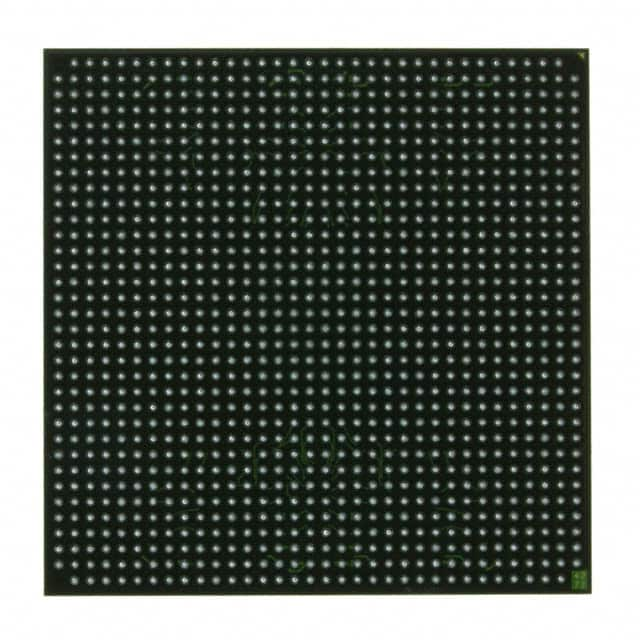Siehe Spezifikationen für Produktdetails.

XC4VFX100-10FF1152C
Product Overview
Category
XC4VFX100-10FF1152C belongs to the category of Field Programmable Gate Arrays (FPGAs).
Use
This product is primarily used in digital logic circuits for various applications such as telecommunications, automotive, aerospace, and consumer electronics.
Characteristics
- High-performance FPGA with advanced features
- Flexible and reconfigurable design
- Low power consumption
- High-speed data processing capabilities
Package
XC4VFX100-10FF1152C is available in a compact package that ensures easy integration into electronic systems.
Essence
The essence of XC4VFX100-10FF1152C lies in its ability to provide customizable digital logic functionality, allowing designers to implement complex algorithms and functions.
Packaging/Quantity
XC4VFX100-10FF1152C is typically packaged individually and is available in varying quantities depending on customer requirements.
Specifications
- Model: XC4VFX100-10FF1152C
- Logic Cells: 100,000
- Maximum Frequency: 500 MHz
- Operating Voltage: 1.2V
- I/O Pins: 1152
- Embedded Memory: 4.8 Mb
- DSP Slices: 192
- Configuration: SRAM-based
Detailed Pin Configuration
The detailed pin configuration of XC4VFX100-10FF1152C can be found in the product datasheet provided by the manufacturer.
Functional Features
XC4VFX100-10FF1152C offers several functional features, including:
- High-speed serial connectivity
- On-chip memory blocks
- Built-in Digital Signal Processing (DSP) slices
- Configurable I/O standards
- Clock management resources
- Integrated PowerPC processor cores
Advantages and Disadvantages
Advantages
- Flexibility and reconfigurability
- High-performance capabilities
- Low power consumption
- Extensive I/O options
- Integration of processor cores for system-level designs
Disadvantages
- Complexity in design and programming
- Higher cost compared to traditional ASICs
- Limited availability of alternative models
Working Principles
XC4VFX100-10FF1152C operates based on the principles of FPGA technology. It consists of a matrix of configurable logic blocks interconnected through programmable routing resources. The device can be programmed to implement desired digital logic functions by configuring the interconnections between logic blocks.
Detailed Application Field Plans
XC4VFX100-10FF1152C finds applications in various fields, including:
- Telecommunications: Used in network routers, switches, and base stations for high-speed data processing.
- Automotive: Employed in advanced driver assistance systems (ADAS) and infotainment systems.
- Aerospace: Utilized in satellite communication systems and avionics.
- Consumer Electronics: Integrated into smart TVs, gaming consoles, and multimedia devices.
Detailed and Complete Alternative Models
While XC4VFX100-10FF1152C is a highly capable FPGA, there are alternative models available from different manufacturers that offer similar functionality. Some notable alternatives include:
- Altera Cyclone V series
- Lattice ECP5 series
- Xilinx Virtex-7 series
These alternative models provide designers with a range of options to choose from based on specific project requirements.
In conclusion, XC4VFX100-10FF1152C is a high-performance FPGA with advanced features, offering flexibility and reconfigurability for various digital logic applications. Despite its complexity and higher cost, it provides significant advantages in terms of performance and power consumption. With its wide range of applications and availability of alternative models, XC4VFX100-10FF1152C remains a popular choice among FPGA designers.
Listen Sie 10 häufige Fragen und Antworten im Zusammenhang mit der Anwendung von XC4VFX100-10FF1152C in technischen Lösungen auf
Sure! Here are 10 common questions and answers related to the application of XC4VFX100-10FF1152C in technical solutions:
Q: What is XC4VFX100-10FF1152C? A: XC4VFX100-10FF1152C is a specific model of Field Programmable Gate Array (FPGA) manufactured by Xilinx.
Q: What are the key features of XC4VFX100-10FF1152C? A: Some key features of XC4VFX100-10FF1152C include 100,000 logic cells, 1152 I/O pins, and a maximum operating frequency of 10 MHz.
Q: What are the typical applications of XC4VFX100-10FF1152C? A: XC4VFX100-10FF1152C is commonly used in various technical solutions such as high-performance computing, digital signal processing, telecommunications, and aerospace systems.
Q: How can XC4VFX100-10FF1152C be programmed? A: XC4VFX100-10FF1152C can be programmed using Hardware Description Languages (HDLs) like VHDL or Verilog, which describe the desired functionality of the FPGA.
Q: Can XC4VFX100-10FF1152C be reprogrammed after deployment? A: Yes, XC4VFX100-10FF1152C is a reprogrammable FPGA, allowing for updates and modifications to the design even after it has been deployed.
Q: What tools are available for designing with XC4VFX100-10FF1152C? A: Xilinx provides software tools like Vivado Design Suite that enable designers to create, simulate, and implement designs for XC4VFX100-10FF1152C.
Q: What is the power consumption of XC4VFX100-10FF1152C? A: The power consumption of XC4VFX100-10FF1152C depends on the specific design and operating conditions, but it typically ranges from a few watts to tens of watts.
Q: Can XC4VFX100-10FF1152C interface with other components or devices? A: Yes, XC4VFX100-10FF1152C supports various communication protocols like UART, SPI, I2C, Ethernet, and PCIe, allowing it to interface with other components or devices.
Q: Are there any limitations or constraints when using XC4VFX100-10FF1152C? A: XC4VFX100-10FF1152C has certain limitations such as limited resources, finite I/O pins, and specific voltage requirements that need to be considered during the design process.
Q: Where can I find more information about XC4VFX100-10FF1152C? A: You can find more detailed information about XC4VFX100-10FF1152C in the official documentation provided by Xilinx, including datasheets, user guides, and application notes.

